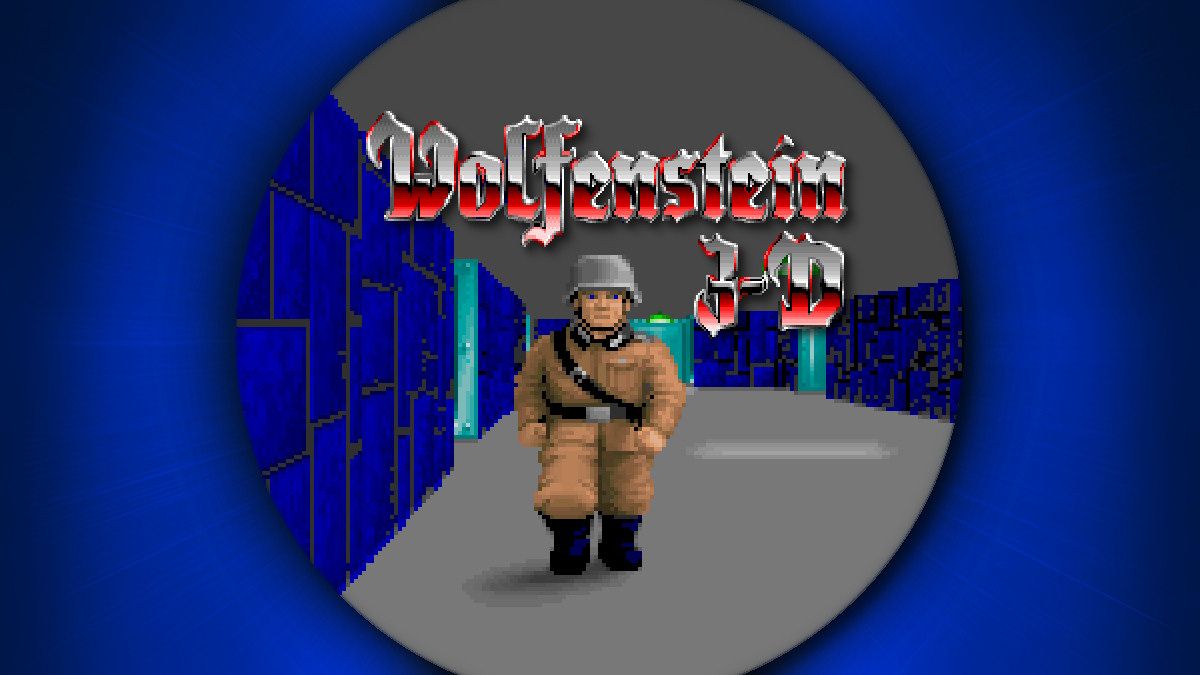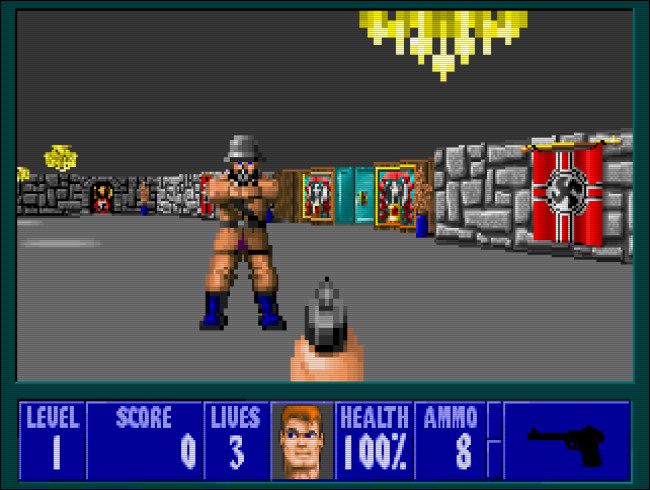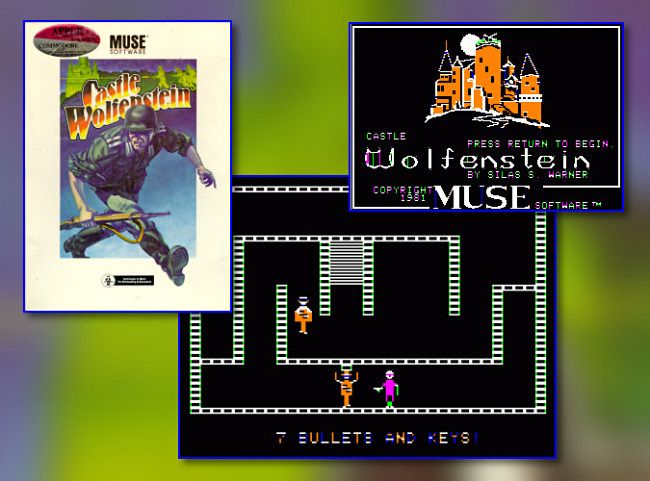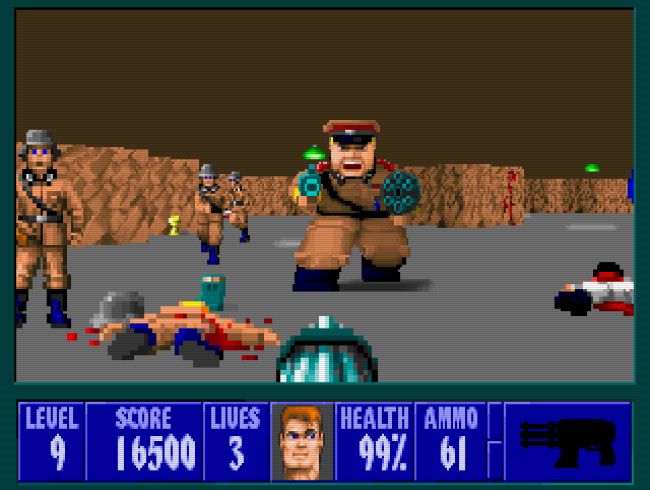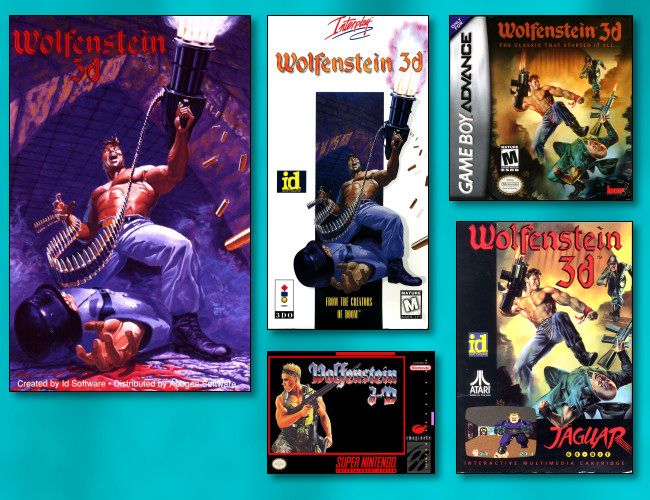Thirty years ago today, id Software released Wolfenstein 3D, a thrilling first-person shooter game set during World War II. It broke new ground for action-based PC games and continued a string of growing successes for id Software. With help from John Carmack, John Romero, and Tom Hall, we'll take a look at what made it special.
The Breakthrough First-Person Shooter
In Wolfenstein 3D, you play as B.J. Blazkowicz, an allied spy during World War II. You must infiltrate Nazi Germany's secret organizations and foil their plans, eventually facing off against Hitler himself. The tools you use to achieve this goal are familiar ones: a knife, a pistol, and machine guns.
Wolfenstein 3D stunned the world at the time of its release with fluid VGA graphics rendered at a high frame rate, dramatic stereo Sound Blaster sound effects (including digitized voices of guards shouting and the clanging of metal doors opening and closing), a satisfying and cohesive theme, and thrilling gameplay. In particular, the positional stereo sound in Wolfenstein 3D was a notable innovation that is often overlooked today. As you rotated your character and moved around, the sound of a distant object or guard would dynamically change (move position or get louder or quieter), which added a great deal to the immersiveness of the game.
While it may look cartoonish today, reviewers considered Wolfenstein 3D especially graphically violent (id Software even voluntarily-but-jokingly rated it "PC-13" for "Profound Carnage" as a warning that displays when you first run the game). Its violence injected a dose of culture shock largely due to its immersive first-person experience, which was novel and somewhat terrifying in 1992. The game placed you directly in the action, with shouting guards hunting you down, and enemies that audibly screamed and collapsed in a pool of blood when you killed them. And you killed not just one person, but dozens in quick succession. The world had never seen anything like it.
Like other id Software games from the early 1990s, Wolfenstein 3D pushed the limits of what people thought was possible graphically with a PC at the time, in no small part due to the programming wizardry of John Carmack. Just as Commander Keen had shown that an average PC could perform console-like scrolling, Wolfenstein 3D proved that a consumer PC could render a high-frame-rate, texture-mapped, first-person 3D environment in VGA. It used a new raycasting technique developed by Carmack to pull off the magic. "It was completely different from the Catacomb-3D and Hovertank One world rendering," says Carmack, referring to two of his previous first-person games. "Those were definitely glitchier, and I was trying to make something rock-solid."
Carmack didn't work alone, of course. The entire id Software team brought Wolfenstein 3D to life, including programming from Carmack and John Romero (with sound driver programming by Jason Blochowiak), masterful graphics by Adrian Carmack, creative design and story direction by Tom Hall, manual design by Kevin Cloud, and key logistical support from Jay Wilbur. Robert "Bobby" Prince provided haunting digitized sound effects and a thrilling MIDI soundtrack that in some cases mixed in elements of historic music from both Nazi and American culture into a blend that served the game very well.
The Origins of Wolfenstein 3D
In retrospect, we can trace Wolfenstein 3D's roots back to a handful of games, including previous first-person games that members of the id Software team had created for Softdisk in 1991: The aforementioned Hovertank One and Catacomb-3D.
After finishing up Commander Keen 4, 5, and 6, the id Software sought a new type of challenge, and they found it when John Romero looked back to two of his favorite classic games: Silas Warner's Castle Wolfenstein, a 1981 top-down Nazi prison escape game for the Apple II, and its sequel, Beyond Castle Wolfenstein (1984).
"That felt right, with Indiana Jones movies and the clearly-bad Nazi enemies being instantly understandable," recalls Tom Hall. Carmack fell in love with the idea too: "We all agreed quickly that shooting Nazis would be great!" After an intensive search by Kevin Cloud, id Software located and bought the rights to Wolfenstein completely for $5,000.
Whereas Castle Wolfenstein's gameplay relied mostly on stealth, id's take on the game was far less subtle, with Romero pushing for heavy action and a high body count. "We originally started with a more complex game based on Beyond Castle Wolfenstein," says Hall, "But the gameplay felt too complex and fiddly for a raw, brutal, quick game."
The team at id developed Wolfenstein 3D at a breakneck pace, completing six episodes of content in just six months. When asked about the biggest challenge during development, Romero replied, "The only challenge was getting 50 levels made in a total of 1.5 months with just me and Tom Hall. This is after shipping the shareware version that had 10 levels and took us 4 months to make."
Carmack felt the development process was fairly painless, relatively speaking. "Compared to many of our other projects, Wolfenstein 3D was a pretty smooth development," says Carmack. "We knew basically what action felt good from Catacomb-3D, and we had better technology and a larger content size to work with."
Near the end of development, Romero and Hall lobbied for Carmack to introduce a way to add secret rooms to the map, accessible by activating false walls. "Romero and Tom had to lean on me a bit to add 'push walls,' because I thought they were kind of ugly in the code implementation," recalls Carmack. "But they were an important design element in the extremely limited space of what we could do with the simple tile maps."
Launch and Legacy
On May 5, 1992, Apogee released Wolfenstein 3D on its official online bulletin board system, Software Creations BBS. As with Commander Keen before it, Apogee Software published id Software's new game under the shareware model it had pioneered with earlier games like Kingdom of Kroz. Players could enjoy the first episode of Wolfenstein 3D for free (and distribute it freely as well). If they wanted more levels to play, they could mail $35 (plus $4 shipping) to Apogee to purchase two more episodes. A few months later, they could pay $50 for six episodes total.
Wolfenstein 3D proved an astounding success almost immediately. Soon it was bringing in $200,000 a month in sales through shareware channels. During a 2009 interview conducted by the author, Apogee head Scott Miller estimated that Wolfenstein 3D sold around 200,000 copies, making it "by far our best seller" in that era, over previous best-sellers that sold 50 to 60,000 copies. With the numerous ports to other platforms (including consoles like the Super NES and Xbox 360) it received over the decades, the game likely sold far more than that.
Wolfenstein also garnered critical attention---and ample praise---from mainstream publications such as Computer Gaming World and PC Games Magazine, which was unusual for a shareware game at the time. "It was like hanging on to the outside of a rocket ship," said Miller of Wolfenstein's success in the 2009 interview. "It was entirely unexpected to that degree. I think that both us and id knew that Wolfenstein was going to be big, but I guarantee you that no one at either company knew it was going to be anywhere close to being as big as it became."
With so much money coming in from Wolfenstein 3D, id Software realized it didn't need Apogee as a publisher anymore, and it decided to go its own way with future releases. Scott Miller didn't hold a grudge: "It was entirely understandable and expected because, at that point, they had learned all they needed to learn from us as far as how to market these things."
Id Software followed up Wolfenstein 3D with a direct-to-retail sequel called Spear of Destiny in late 1992, and Apogee (under the direction of Tom Hall after he left id) developed a proposed sequel to the game that turned into Rise of the Triad in 1994. Other than that, the id crew got to work on their next big project, Doom, which would improve dramatically on the Wolfenstein 3D engine and bring even greater success to the small company.
In the many years since Wolfenstein 3D's release, several firms have revived the brand with games like Return to Castle Wolfenstein in 2001, a follow-up by Raven Software in 2009, and a successful critical run of titles by MachineGames that began in 2014. Today, Romero is happy with how the series has proceeded. "There has been some great experimentation with the concept over the years," says John Romero. "MachineGames really just owned it. I wouldn't change a thing. I'm happy with the expansion of the story and characters, introducing B.J.'s daughters, Jes and Soph."
Looking back, Carmack is also very pleased with how Wolfenstein 3D turned out: "While it was overshadowed by Doom, it still clearly showed that first person perspective could be used for action games, not just simulation games," he says. "We could have brought multiplayer to the Wolfenstein technology generation, but moving on to Doom was The Right Thing To Do."
Hall is similarly reflective, calling Wolfenstein 3D "amazing and fun," while also delighting in the majesty and wonder of breaking new ground: "When we were testing some levels, we were playing and kinda went, 'No one's made this before...like, is that okay?' What a rare honor to design the fundamental building blocks of a genre. Who gets to do that?"
Even 30 years later, Wolfenstein 3D is still fun. You can play the original PC shareware version of the game for free on the Internet Archive, or purchase the full game on Steam. Happy birthday, Wolfenstein 3D!

